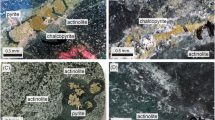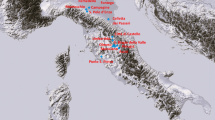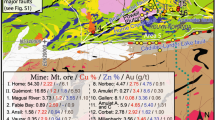Abstract
THE idea that the lead in many large ore bodies originates from a uniform, deep-seated, possibly upper-mantle, source region1 has proved of great value, particularly in the recognition and interpretation of the systematics of “anomalous” (“multi-stage”) lead systems. When these so-called “single-stage” or “primary” lead deposits came to be examined in greater detail2, however, the situation turned out to be not quite so simple; it led Kanasewich and Farquhar3, for example, to conclude that “no infallible geologic criteria have been found for independently distinguishing ordinary or single-stage leads from those which were produced in two or more distinct lead–uranium–thorium systems”. Other indications of the need for re-examination of current ideas about the “primary lead” system are the many geophysical data which suggest lateral inhomogeneities in the upper mantle4, supported by isotopic data which suggest long-term inhomogeneities in its U/Pb ratio5, and the contention by Hobbs and his co-authors6 that the seemingly stratiform nature of the deposit at Broken Hill, NSW, may be not quite so directly the result of sedimentary processes as has been asserted7.
This is a preview of subscription content, access via your institution
Access options
Subscribe to this journal
Receive 51 print issues and online access
$199.00 per year
only $3.90 per issue
Buy this article
- Purchase on Springer Link
- Instant access to full article PDF
Prices may be subject to local taxes which are calculated during checkout
Similar content being viewed by others
References
Wilson, J. T., Russell, R. D., and Farquhar, R. M., Canad. Min. Met. Bull., 49. 550 (1956).
Ostic, R. G., Russell, R. D., and Stanton, R. L., Canad. J. Earth Sci., 4, 245 (1967).
Kanasewich, E. R., and Farquhar, R. M., Canad. J. Earth Sci., 2, 361 (1965).
Anderson, D. L., in The Earth's Mantle (edit. by Gaskell, T. F.), 365 (Academic Press, NY, 1967).
Cooper, J. A., and Richards, J. R., Earth Planet. Sci. Lett., 1, 259 (1966).
Hobbs, B. E., Ransom, D. M., Vernon, R. H., and Williams, P. F. (in the press).
Carruthers, D. S., and Pratten, R. D., Econ. Geol., 56, 1088 (1961).
Oversby, V. M., Compston, W., and Gast, P. W., Trans. Amer. Geophys. Un., 49, 348 (1968).
Cooper, J. A., and Richards, J. R., in Hot Brines and Recent Iron Formations in the Red Sea (edit. by Degens, E. T., and Ross. D. A.) (in the press).
See Stanton, R. L., and Rafter, T. A., Mineralium Deposita, 1, 16 (1966).
Shaw, D. M., Econ. Geol., 52, 570 (1957).
Cannon, jun., R. S., Pierce, A. P., Antweiler, J. C., and Buck, K. L., Econ. Geol, 56, 1 (1961).
Various articles in Ore Deposits of Australia (second ed.), 1, of Publications, Eighth Commonwealth Mining and Metallurgical Congress, Australia (1965).
Richards, J. R., Proc. Austral. Inst. Min. Metall., 218, 19 (1966).
Doe, B. R., Hedge, C. E., and White, D. E., Econ. Geol., 61, 462 (1966).
Park, jun., C. F., and MacDiarmid, R. A., Ore Deposits, 110 (Freeman, San Francisco, 1964).
Russell, R. D., and Reynolds, P. H., Vozrast Zemli, in Problemi Geoklimii Akad. Nauk. S.S.S.R., 37 (1965).
Author information
Authors and Affiliations
Rights and permissions
About this article
Cite this article
RICHARDS, J. “Primary” Leads. Nature 219, 258–259 (1968). https://doi.org/10.1038/219258b0
Received:
Revised:
Published:
Issue Date:
DOI: https://doi.org/10.1038/219258b0
This article is cited by
-
Lead isotopes in island arcs
Bulletin Volcanologique (1971)
Comments
By submitting a comment you agree to abide by our Terms and Community Guidelines. If you find something abusive or that does not comply with our terms or guidelines please flag it as inappropriate.



